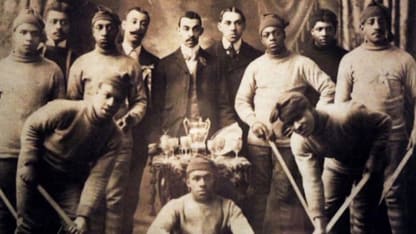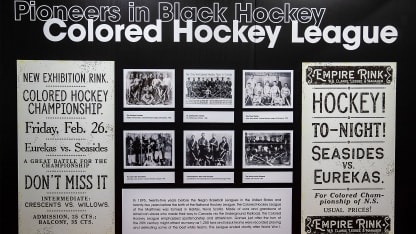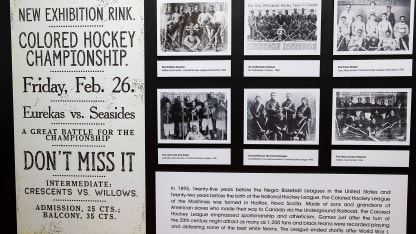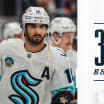Fast, physical and innovative. These are the words used by newspaper reporters to describe the Colored Hockey League of the Maritimes established in 1895. Sixty-three years before Hockey Hall of Famer Willie O'Ree became the first Black player to suit up in the National Hockey League, dozens of all-Black teams competed on the ice in the Nova Scotia in the late 1800s, forming the first-ever professional hockey league, the CHLM.
In fact, modern staples of the game including the slapshot and a goaltender's butterfly technique can be traced to CHLM. Eddie Martin invented the slapshot technique playing for the Halifax Eureka in 1906. Henry "Braces" Franklyn was the first goalie to fall to the ice to cover a puck when the CHLM made it allowable in 1900. Other early 1900s leagues still ruled goaltenders had to remain standing during play and it was only when the NHL was established in 1917 that goalies were widely approved to leave their feet to make saves and cover the puck.
The Original Sixes
The first-ever pro hockey league, established in 1895, skated lineups and shifts of three forwards, two defensemen and a goalie. Every player was Black.

Martin and Franklyn were two among hundreds of CMHL players who were at most two generations removed from those of their family members who journeyed to freedom and established roots in Halifax. As part of the Kraken marking Black History Month, we spoke to historian and sportswriter Bob Dawson about the origins of Black hockey history and his hopes for future players of color.
Like many others, Dawson first learned about the Colored Hockey League from the 2004 book, "Black Ice: The Lost History Of The Colored Hockey League Of The Maritimes 1895-1925," written by historians George and Darrill Fosty. The siblings were researching the connection between New York and Nova Scotia by way of the Underground Railroad when they came across newspaper clippings about a collection of all-Black hockey teams. The brothers were intrigued and decided to pursue the leads.

"They visited Halifax, the Dartmouth area, and met and spoke with descendants of several CHLM players in the hockey league," Dawson said. "They reviewed the research and archives to pull together the information."
In 2006, Dawson reached out to congratulate the brothers on what he called a groundbreaking book. The three became quick friends and even founded and coordinated the Black Ice Hockey and Sports Hall of Fame Conference and Induction that same year, following up with more ceremonies in 2007 and 2008.
"The intent of the conference was to create a greater awareness within the Black community, but also in the broader hockey community, of the historical significance of the Colored Hockey League," said Dawson.
The CHLM was founded by Pastor James Borden, James A.R. Kinney, James Robinson Johnston and Henry Sylvester Williams. Each founder was known as an intellectual. Kinney was recognized at the first Black graduate from the Maritime Business College and Johnston was the first Black graduate from the Dalhousie University law school and known as the first Black Nova Scotian to graduate from college.
The Dartmouth Jubilees were the first CHLM team. Opponents emerged from already established baseball teams, such as the Africville Seasides and the Truro Victorias with players looking for a sport to play when weather wasn't, well, baseball weather. For members of Black communities like Africville, hockey wasn't just a chance for winter competition. It was a social event.
"The games were more than a hockey game," said Dawson, "it was like a celebration. To the point where these teams were outdrawing the white senior league teams. White teams were drawing between 300 to 500 people. The teams within the Colored Hockey League were drawing between 1,200 to 1,500 fans."
At a time when racism instructed so much of how Black people lived their lives, an all-Black hockey league served as a safe space. Focusing on faith and community, the organizers of the Colored Hockey League hoped the game could serve as an equalizer.
"They saw this as an opportunity to move up socially and climb up a social ladder and gain equal footing with the larger white community," said Darril Fosty in a 2008 short-form ESPN documentary.
Watch: ESPN segment on "Black Ice"
"The ultimate goal being that one day, Blacks will be equal and sport will be the catalyst for that to occur."
Over its first 15 years, the CHLM had difficulty keeping afloat. The league folded in 1911 and was temporarily revived in 1925 before closing down during the 1930s.
The CHLM was particular doomed by a proposed expanded rail service to Halifax in 1906. Black community members, including league organizer Johnston attempted to stop the annexation of the land. Court battles led to political battles which led to businesses taking sides in favor of the government.
"[The CHLM] angered these railroad barons," George Fosty said in the 2016 documentary, "Soul on Ice: Past, Present and Future." "What you started to see is efforts to deny blacks a livelihood."

Newspapers and especially rink owners started to squeeze Africville's Black community and, with it, the CHLM. For decades, Africville struggled before its land area was bulldozed to the ground in 1970. Forty years later, Halifax issued an official apology for the forcible relocation and rebuilt a church structure that now serves as a museum.
From the 1930s to O'Ree NHL debut in 1958, one might assume Black players didn't exist or weren't capable or both.
"There were some bizarre theories that were embraced and espoused with respect to Blacks having weak ankles," explained Dawson. "That [Blacks} had an aversion to the cold. They didn't have the intelligence or the skills not only to play the game, but to organize the game. And so consequently, that kind of thinking went on to pervade throughout the evolution and development of hockey."
Since linking up with the Fostys, Dawson has been committed to reclaiming and honoring the history of the Colored Hockey League. In 2016, he began a campaign to honor the CHLM on a Canadian Stamp. Three years later, the stamp was approved and was officially released last January for the 125th Anniversary of the league.
Black excellence and innovation in hockey has been around since the sport's formative years. The Colored Hockey League of the Maritimes (1895-1930) was the first to allow goalies to leave their feet + was where the slapshot was invented! #BlackHockeyHistory | #BlackHistoryMonth pic.twitter.com/hhy7d1jKzq
— Hockey Hall of Fame (@HockeyHallFame) February 5, 2021
During Black History Month last season, the Ottawa Senators invited descendants of CHLM players to participate in an
honorary puck drop
alongside O'Ree. The Senators hosted a commemorative game honoring the CHLM. Dawson is thrilled the Colored Hockey League of the Maritimes is being remembered. He is optimistic other NHL teams and the league will take more bold steps towards equality and inclusion.
"With respect to Black History Month and beyond, I plan to, again with my colleagues at Black Ottawa History, approach teams to become more involved to take positive action with respect to the kinds of initiatives that the NHL publicly announced last September," said Dawson.
Dawson said he would like to see NHL teams embrace the
International Decade of People of African Descent
(IDPAD) as laid forth by the United Nations. Without question, Dawson and the Fostys have initiated a greater awareness of the Colored Hockey League of the Maritimes. Yet, Dawson believes the NHL can more permanently memorialize the pioneers of modern hockey.
"I think for me, for them to do the league justice," Dawson said, "wouldn't it be nice to have a trophy or plaque or something honoring the Colored Hockey League for its contributions?"


















